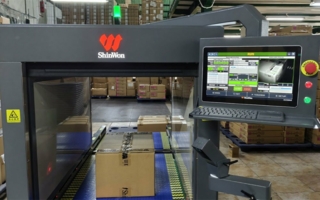14/03/2022
The impact of Covid-19 and the supply chain disruptions
Remember the pre-pandemic period when economic indicators raised hopes of a sustained growth and robust demand? The hopes were dashed after the dreaded Covid-19 struck the textile and garment sector, followed by the supply chain disruptions.
The American textile industry tried to do some damage control against what seemed a deteriorating situation. A bright spot in the gloomy picture was the reprogramming by textile and apparel manufacturers to adapt themselves to the demand for specific products. For example, some U.S. factories that manufactured hoodies and t-shirts, began to also produce textile face masks to meet the overwhelming demand for these products. Indeed, demand was so high that hospitals in some states faced problems due mask shortages. The supply situation has, meanwhile, eased compared to 2021.
As Covid-19 proliferated, the U.S. administration called on the Defence Production Act (DPA) to expand production of hospital masks and protective gear. The DPA, enacted in 1950, gives the government a wide range of powers to enlist private companies to help deal with the national crisis.
While the established mask manufacturers are Americans, the actual manufacturing is done outside the U.S. According to U.S. Census Bureau data, some 71% of U.S. customs import value in made-up textile articles, including face masks, were imported from China in January 2020.
Supply chain needs more resilience
The supply chain disruption hit the textile industry at a crucial time. The textile sector, which is time sensitive, and must quickly adapt to seasonal changes and fashion trends, also faced logistics challenges during the pandemic. Retailers, who depend on timely arrival and distribution of products, feared that delays in receiving goods could affect the interest of their loyal customers. Indeed, many retailers faced the twin problems of dwindling stocks and delays in delivery schedules.
Stephen Lamar, president and CEO of the American Apparel & Footwear Association (AAFA), has described shipping delays as a key “pressure point within the apparel supply chain”. “The ongoing shipping crisis and port backups – paired with tariffs on U.S. imports from China and fuelled by Omicron – has been more than a pain or pressure point – it is an existential threat for many businesses across our supply chain,” Lamar recently said.
Experts feel that buyers could manage their requirements better if they could establish supply sources closer to the consumer markets or identify suppliers located in consuming markets to avoid future disruptions and delays. New Kearney study underscores urgency to make supply chains more resilient.
Unanticipated skyrocketing costs
According to the latest study by global consultancy Kearney on the impact of Covid on North American apparel and footwear retail, the continued supply chain disruptions could cost the North American apparel and footwear industry up to $ 17 billion in lost earnings. Indeed, this is a conservative estimate, considering it was done before the outbreak of the omicron COVID-19 variant.
Supply disruptions in 2021, made it difficult for textile and apparel companies to meet rebounding consumer demand; several major apparel brands reported tepid sales growth, attributed partly to failed efforts to get products to consumers when demand started to rebound.
North America’s apparel and footwear industry also endured a variety of unanticipated cost increases in 2021, including the cost of cotton (+40%), transpacific container shipping (+300%) air freight (+50%), and OTR freight (+20%), while labour shortages drove up logistics, warehousing, and retail wages,
“Our 2022 analysis explored the industry’s vulnerability to ongoing supply disruptions and cost shocks,” said Greg Portell, lead partner of Kearney’s Global Consumer Practice, advising companies to respond to the situation with resilience.
Brian Ehrig, a partner at Kearney’s New York office, recommended companies to change their strategies and improve their resilience by resorting to nearshoring and reshoring to make their supply lines less vulnerable, while also building up regionalized supply chains within their existing footprint. “Platforming could also have a big impact, as we often find high levels of fabric commonality and interchangeability across brands that is underleveraged. Apparel and footwear companies can use that commonality to reduce costs and flexibly prioritize within their product portfolio when disruption strikes."
The state of U.S. textile and apparel manufacturing
After decades of decline, textile and apparel manufacturing in the U.S. had been gradually gaining in strength. U.S. textile manufacturing output, in value-terms, totaled $ 18.79 billion in 2019 (up 23.8% from 2009) while apparel manufactured had declined to $ 9.5 billion in 2019 (down from 4.4% over 2009) according to Bureau of Economic Analysis, 2021.
While Covid-19 adversely affected the textile and apparel production in the first half of 2020, it started to recover in the 3rd quarter. As of September 2021, U.S. textile production had resumed about 98.5% of its pre-Covid production capacity.
U.S. textiles and apparel products also figure in global exports; nearly 42% of U.S. textiles were exported to foreign markets in 2019, up from only 15% in 2000. The U.S. today is a net textile exporter; however, it a net apparel importer. Covid-19 has impacted U.S. textile and apparel trade.
The U.S. market remains attractive also for international textile machinery suppliers who, while increasing their share of the Asian markets, are also keeping their sights on the U.S. market.
Some machinery suppliers such as Turkey’s Picanol believe that digitalization and optimization would be the key to overcoming challenges. They maintain that the textile industry had faced new challenges in the last two years such as supply chain disruption, large fluctuations in the availability, rising costs, raw materials and uncertainty in the markets, leading to new business models.
According to Picanol, the weaving machinery industry was very active in 2021; this trend should continue in 2022. “We believe that 2022 will reveal many new developments in that field,” said a Picanol representative. This view is also generally shared by other international textile machinery suppliers.
Manik Mehta, U.S. Correspondent, New York




